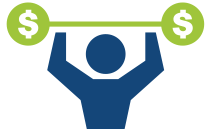fundraising
Making A New Year’s Fundraising Fitness Resolution
 My gym is full this week. Many of us have New Year’s resolutions to get in shape, and the gym should be packed for the next few months. The new year is also a great time to evaluate the fitness of your fundraising program. Do you have a resolution to get your program in better shape? Here are some ideas to get started…
My gym is full this week. Many of us have New Year’s resolutions to get in shape, and the gym should be packed for the next few months. The new year is also a great time to evaluate the fitness of your fundraising program. Do you have a resolution to get your program in better shape? Here are some ideas to get started…
Get a Baseline
Over the past few years, some great comparative tools have arrived through data sharing collaborations, from the AFP Fundraising Effectiveness Project to the great online giving data provided by Network for Good. In higher education, the VSE survey is a great tool, along with the CASE Fundraising Index. These and other sources can give you some idea of how you compare to national peers. It’s also a great time to network with colleagues at similar institutions.
Get a Personal Trainer
There are plenty of experts out there asking important questions and providing answers, from industry bloggers like Michael Rosen and Penelope Burk as well as white papers and new research being released throughout the year. Invest some time in webinars, many of which are free, and the paid webinars you can join from national organizations or offered by your particular professional association will be worth the investment if you invest the time afterward to apply the knowledge to your program and goals. It might also be time to get a personal “coach,” a fundraising consultant to help your organization evaluate and develop a plan for the year.
See What the Kids are Doing
Fundraising is a rapidly changing field, with channels like crowdfunding and online giving contributing more each year to the total effort. If your program hasn’t investigated some of these new strategies, it’s about time. If you’re sending the same old direct mail pieces when other causes are using custom links, videos, and social media, you’re probably seeing a decline as your traditional donors age. Take a look at what you can do to engage a different population. You don’t want to be stuck in Jazzercise while everyone else has moved on to Zumba.
Evaluate and Make Corrections
Your program may hit complications, plateaus, or even suffer an injury as you work on its fitness. Turnover on your team is likely your biggest risk, but you could also see an appeal fail or underperform. It’s important to ask: “Why did this happen?” Find the best and most useful information you can about the source and potential solutions and move forward. Above all, if you’re looking to make corrections, you can’t do it in isolation from the data or your professional support network. Other people are having the same fundraising fitness challenges, and you don’t have to go it alone.
Just like a personal fitness plans, setting reasonable goals and developing long-term habits is the key to the fitness of your fundraising program. Industry statistics show that up to 80% of gym memberships go unused by the end of the year. Set a goal to make evaluation, development, and overall fitness of your fundraising program something that you focus on for a little time each week instead of “business as usual” in the new year. It will pay off, and your cause and donors will benefit.
I’ll see you at the gym.